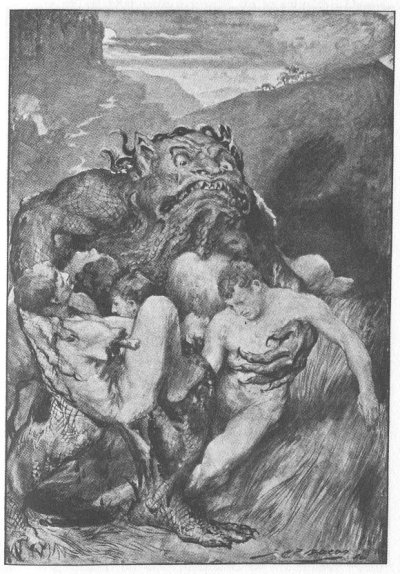The antagonistic force of evil has been a common theme in society and literature, it can be manifested into various forms, functions, and interpretations. Evil follows the law of relativity and thus differentiates from each point of view and situation.
Although evil is not truly existent, necessarily, classical literature manages to portray evil in supernatural and symbolic manifestations. The tale of Beowulf and Geoffrey Chaucer’s “The Pardoner’s Tale” depict these two contrasting manifestations of evil as supernatural beings and the sin of avarice.
Evil can be present in many forms, however, the manifestations of evil in Beowulf and “The Pardoner’s Tale” are contrasted primarily by the degree of their externality. The story Beowulf portrays an extremely high degree of externality because the antagonists are supernatural beings that descended from Cain.
The author emphasized the immorality of the clan by adding grotesque physical characteristics exemplified in the following quote: “He strode quickly across the inlaid / Floor, snarling and fierce: his eyes / Gleamed in the darkness, burned with a gruesome / Light” (Beowulf 300-302).
Unlike Beowulf, “The Pardoner’s Tale” portrays a significantly low degree of externality in the presence of evil because avarice (the tale’s specific manifestation of evil) is an internal temptation within the three rioters, not a physical object or being.
Another differentiation in the manifestations of evil in the two tales is their correspondence to the culture of the era they were written in. During the Anglo-Saxon era, the influence of Christianity had recently been introduced; however, pagan values were still instilled. Due to the Anglo-Saxon beliefs, Beowulf contains supernatural beings and monsters that were to be defeated by physical means.
In contrast, “The Pardoner’s Tale” was written during the medieval era in which Christianity was significantly more predominant; thus the sin of avarice was an internal temptation that must overcome by spiritual strength. The influence of religion in “The Pardoner’s Tale” inspired the theme, money is the root of all evil, which also makes it an allegory. “That thou, to thy Creator, Him that wrought thee, / That paid His precious blood for thee and bought thee, / Art so unnatural and false within? / Dearly beloved, God forgive your sin / And keep you from the vice of avarice!” (Chaucer, “The Pardoner’s Tale” 325-329).
Thus the quote above explains the consciences of greed, why this form of evil must be resisted, and commands people to pay the pardoner to pardon their sin of avarice.
In addition to the blatant presence of evil in Beowulf and “The Pardoner’s Tale,” the manifestations of evil provide vital essences to the plots by providing motivation for the main character(s) and create action in the literary work. In the tale of Beowulf the demon, Grendel, attacked the mead hall which incited Beowulf to murder Grendel for the sake of honor.
“That I alone and with the help of my men, / May purge all evil from this hall” (Beowulf 260-261). However, the sin of avarice provides motivation through temptation in “The Pardoner’s Tale.” This “evil” temptation motivated each of the three rioters to unknowingly plot against each other and receive the ultimate punishment for their sins, death.
Although to the tale of Beowulf and “The Pardoner’s Tale” may contain two entirely different states of evil, each form of evil provided vital motivation for the action in their plots that also corresponded to the culture of their written settings. Evil may be portrayed as physical beings, but in reality, no object or being is truly evil. Only characteristics and ideas may be evil; which thus makes evil simply a metaphysical constituent of literature and the physical realm.

